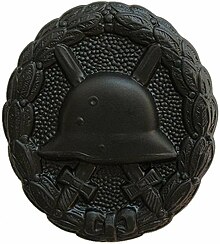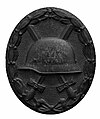Wounded badge
The Wound Badge was a German military award for soldiers wounded on duty , which was first donated in 1918 by Kaiser Wilhelm II .
Wound Badge (1918)
On March 3, 1918, Wilhelm II donated a Wound Badge as an award for wounded members of the German Army (including airmen, airship and balloon troops) in World War II . It could also be awarded to members of the colonial troops in the German colonies since July 8 of the same year .
The award regulations said u. a .: I want to give a badge to those wounded in the service of the fatherland as a special recognition. The badge is intended to honor those who have bled for the fatherland or who have lost their health in a war zone through enemy action and are consequently incapacitated.
The badge was awarded in three stages:
- in black (for one and two wounds)
- in silver (for three and four wounds)
- in gold (for five or more wounds)
Navy wounded badge
For the members of the Imperial Navy , Wilhelm II donated a similar naval wounded badge on June 24, 1918 , which differed externally through the depicted image. Here, too, three levels were assigned, which were named black, matt white and matt yellow. The award was only given to those wounded in naval battles.
Winners of the award who suffered another wound in army service from 1939 were ordered to exchange them for the Wound Badge (1939) during World War II .
| Navy wounded badge | ||||||
|---|---|---|---|---|---|---|
| in black | in matt white | in matt yellow | ||||
Awarded the Wound Badge of the First World War
Most of the World War I wounded badges were only awarded on application after the end of the war. Applications had to be submitted to the military authorities until 1933. When the National Socialists came to power , the supply offices of the cities were responsible for the applications. The applicant required proof of the wound with military certification.
Wound badge for Spain fighters
The Wound Badge for German volunteers in the Spanish struggle for freedom was donated by Adolf Hitler on May 22, 1939 . It honored those soldiers who, as members of the Condor Legion, fought on the side of the Falangist General Franco in the Spanish Civil War (1936-1939) and were injured during their deployment or in Spanish waters. If wounded once or twice it was awarded in black, and if wounded three or more times it was awarded in silver. A total of 182 black and one silver wound badge were awarded. There was, however, no gold award. Nevertheless, it should be mentioned that the wounded badge of the “1. Form ”was awarded in the gold level up to 1940, because the wounded badge (1939), which had meanwhile been donated, was not yet available in sufficient quantities, especially during and after the attack on Poland .
| Wound badge for Spain fighters | ||||||
|---|---|---|---|---|---|---|
| in black | in silver | in gold | ||||
Wound Badge (1939)
The Wound Badge (1939) was donated on September 1, 1939. It honored those soldiers who were wounded in the Second World War through enemy action or through no fault of their own, or who were injured by severe frostbite during combat operations. For one and two wounds it was awarded in black, for three and four wounds in silver, and for more than four wounds in gold. In the event of severe injuries, a step could be skipped. The badge was placed on the left side of the chest - mostly on the breast pocket - offset below the war decorations, but above the badges of honor of the NSDAP and the various recognized sports badges.
Wounds in World War I , during operations against revolutionaries from 1918 to 1920 as well as in the so-called border guard battles ( Carinthia 1918/19 , Silesia 1918-21 ) and in the Spanish Civil War could be taken into account when determining the respective level.
| Wound Badge (1939) | ||
|---|---|---|
| in black | in silver | in gold |
Wound badge July 20, 1944
The Wound Badge July 20, 1944 , was donated by Adolf Hitler in August 1944 and awarded to all persons who were injured or killed in the July 20, 1944 assassination attempt . The award, made of solid silver , is similar to the Wound Badge from 1939. Under the steel helmet, however, there is also the two-line inscription 20 JULY 1944 and the facsimile of Hitler's autograph.
The Wound Badge July 20, 1944 was awarded in an official ceremony on September 2, 1944 to 24 people, three of them posthumously . Hitler himself accepted the award, but never wore it.
Subsequent awarding and wearing instructions after 1945
As after the First World War, authorization to wear the badge for the wounded can also be applied for after 1945 in accordance with Section 13 of the Ordinance on Proof of Proof of Medals and Badges of Honor and Proof of Wounds and Damage . The prerequisite is evidence of war-related wounds or damage in accordance with the provisions on war victims' provisions. According to the law on titles, medals and decorations of July 26, 1957, the award may only be worn without a swastika .
This does not include the Wound Badge for German volunteers in the Spanish struggle for freedom and the Wound Badge July 20, 1944 , neither of which may be worn in any form in Germany.
| Wound badge in the 57 version | ||||||
|---|---|---|---|---|---|---|
| in black | in silver | in gold | ||||
See also
literature
- Kurt-Gerhard Klietmann : German awards - a history of decorations and medals, commemorative and merit badges of the German Reich, the German states and government agencies, organizations, associations, etc. from the 18th to the 20th century. In cooperation with the International Society for Scientific Order Studies e. V Volume 2: German Empire. 1871-1945. The Order Collection, Berlin 1971.
- Jörg Nimmergut : German medals and decorations until 1945. Volume 4: Württemberg II - German Empire. Central Office for Scientific Ordinance, Munich 2001, ISBN 3-00-001396-2 , pp. 2228–2229.
- Dietmar Hinze: The Prussian Wound Badge from 1918. Comments on its foundation 100 years ago. In: Orders and Medals. The magazine for friends of phaleristics , publisher: Deutsche Gesellschaft für Ordenskunde , issue 114, 20th year, Gäufelden 2018. ISSN 1438-3772.
- Sascha Zimmermann: The Wound Badge July 20, 1944 and its awards. In: Orders and Medals. The magazine for friends of phaleristics , publisher: Deutsche Gesellschaft für Ordenskunde , issue 124, 21st year, Gäufelden 2019. ISSN 1438-3772.
Individual evidence
- ↑ Information board at the LVR-Industriemuseum Oberhausen , accessed on May 25, 2016.
- ^ Jörg Nimmergut: German medals and decorations until 1945. Volume 4: Württemberg II - German Empire. Central Office for Scientific Ordinance, Munich 2001, ISBN 3-00-001396-2 , pp. 2228–2229.












